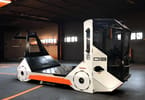INDIA (eTN) – “Camel trips, as I suspected all along, and as I was about to have confirmed, do not begin or end: they merely change form.” – Robyn Davidson
What do camels do at night while on a safari in the Great Indian Desert, more commonly referred to as the Thar Desert? It’s a mixture of chewing on cud, breaking wind, and resting, and not necessarily in that particular order. On our first night out, under the canopy of a billion stars, we made the cardinal mistake of sleeping not too far from the over-exerted camels in the direction of the wind – the net result was a night full of unpleasant whiffs in the air and the sound of grinding teeth. The camels didn’t give a damn, though.
Besides this minor blemish, camel safaris in India are a delightful experience, thanks mainly to the varied topography of the unassuming desert, the eccentric behavior of the camel wallahs (riders), and the near faultless performance by the camels in the daytime. One assumes the wayward behavior of the camel riders can be ascribed to the fact that being exposed to the relentless sun, sand, and wind for a major portion of their lives, brings about bouts of unpredictable behavior that can plainly be described as funny in lighter moments and frustrating when the back begins to throb after hours of riding. The camels themselves have an uncanny sense of direction, and for the most part are pretty amiable and docile.
Riding a camel isn’t a particularly daunting task, getting onto one is more demanding. It calls for flexibility and dexterity, as one needs to stretch to finally be able to reach the other side. Once firmly entrenched in the saddle, the next step is to do exactly the opposite of what the camel does, move backwards as the camel steps backwards to rise on its forelegs, and move forward when she raises hind legs. That accomplished, riding is then a pipe dream, although the rule of thumb is to keep the upper portion the body loose and nimble to be able to sway to the movements of the “ship of the desert.” It isn’t for nothing that the camel has been given this term, as its movements over desert sand and scrub can overwhelmingly be compared to that of riding a wave in the raging ocean.
Entry to the Thar Desert is from the fairy tale-inspired town of Jaisalmer in Western Rajasthan, founded by Prince Jaisal in 1156 and on the trading route across the deserts from India to the western world. The Jaisal Fort, with 99 bastions, watch towers, and turrets, stands 76 meters above the town on top of the Trikuta Hill in Jaisalmer. When seen from a distance, the fort with its crenellated sandstone walls shimmers and shines in the evening light of the setting sun, creating a surreal medieval atmosphere. Inside the fort, it’s a collection of mansions (havelis) exquisitely carved with Jurassic sandstone, having latticed windows. Residence to more than 5,000 locals, the fort has residential quarters built with mud and mortar, and a motley group of temples and numerous shops selling handicrafts, tote bags and designer shoes from camel hide, as well as painted bedspreads. Not short on enterprise, locals entice tourists with polished German, French, and Spanish. Necessity is the mother for (learning) all languages.
Our camel safari was no different from the others, yet at moments it felt it was like a ride through life itself. Sunrises and sunsets were always mesmerizing – the sky painted in flaming orange with the piercing rays lighting the contours of the dunes. During the course of the day, the mood changed from lively to listless, the sun playing no mean influence in dictating its course. At its fiercest, we took umbrage under the shade of the sparse (khejria) trees – this was our oasis. After a brief lull during which we chose to nimble on sparse meals consisting of lentil and roasted bread, we were availed of an opportunity to know our fellow travelers and exchange notes. We set out again stopping to stare at abandoned villages and unkempt ruins that had somehow managed to remain standing, despite the vagaries of nature and time.
While on the trot, we admired the ever-changing beauty of surrounding landscapes. Colors flirted and danced before our eyes – amazing shades of brown, pastel, indigo, and green. One moment we had a precarious climb past hills over stone and scree, the next saw the camel wobbling on loose sand dunes struggling to maintain balance. There were occasions when the cloud blocked out the sun resulting in the descent of a fierce wind, creating an uproar in the dunes, the swirling sand almost resembling an hour glass. Soon, quiet would descend. A conclusion seemed inevitable: change is a predominant factor, be it in the vast concourse of the desert or in this mysterious journey called life itself.
Our journey across the vast expanse of sand was not without moments of hilarity, and was best exemplified when answering the call of nature. As this was a cheapie camel safari, there were no chemical toilets or makeshift ones, it was simply a pit one dug for the “big job,” before covering it back up again with sand. Speaking of pungent odors, we (as well as the camels) were all partners in crime. Thank goodness the unsuspecting desert “absorbs” it all.
WHAT TO TAKE AWAY FROM THIS ARTICLE:
- On our first night out, under the canopy of a billion stars, we made the cardinal mistake of sleeping not too far from the over-exerted camels in the direction of the wind – the net result was a night full of unpleasant whiffs in the air and the sound of grinding teeth.
- One assumes the wayward behavior of the camel riders can be ascribed to the fact that being exposed to the relentless sun, sand, and wind for a major portion of their lives, brings about bouts of unpredictable behavior that can plainly be described as funny in lighter moments and frustrating when the back begins to throb after hours of riding.
- That accomplished, riding is then a pipe dream, although the rule of thumb is to keep the upper portion the body loose and nimble to be able to sway to the movements of the “ship of the desert.






















